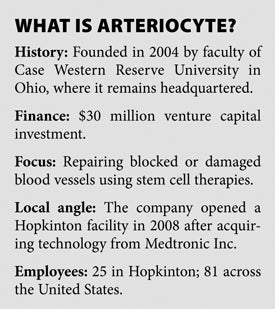Humans can make all sorts of fascinating and useful things, but scientists know that nature often does it best.
Arteriocyte, a Cleveland-based clinical-stage biotech company with operations in Hopkinton, has spent the last seven years using healing components found within the human body to better treat severe injuries sustained by military personnel on the front lines.
At The Molecular Level
The company has developed non-embryonic stem cell-based technology that concentrates platelets and white blood cells into injectable plasma. That plasma can be injected at the site of a wound to speed up healing and prevent infection.
The product, called Magellan, separates plasma from blood and dispenses it into a syringe. The concentrated plasma can reduce risk of infection and speed up tissue healing.
“The whole basis of the company’s creation was driven by the mindset that the human body has all the building blocks of tissue repair within each of us,” said Don Brown, Arteriocyte’s CEO. “The human body’s system of feeding the cells and driving the differentiation is one of the most efficient bioreactors you can have.”
Arteriocyte is working on another process at which the body currently reigns supreme: making blood. It hopes to develop a system that will grow red blood cells on a large enough scale where the military would have a fresh supply of universal blood with no donors required.
Arteriocyte has been working with the Pentagon’s Defense Advanced Research Projects Agency (DARPA) since 2008 to develop methods of producing “culture blood” for military surgeons on the front lines. The product, named Nanex, mimics the bone marrow environment to encourage the growth of stem cells that can then be converted to red blood cells.
A fresh supply of blood for transfusions would be superior to donor blood, Brown said, because the latter is often several weeks old by the time it reaches military surgeons who use it for transfusions. That’s compared to a much quicker trip blood makes to domestic hospitals for civilian patients.
“In reality, there’s a difference between fresh blood that is available to those in the military on foreign soil versus fresh blood donated here in the U.S.,” he said.
Blood that is 14 days old or greater poses a higher risk of infection and organ failure, according to a 2008 study by The Cleveland Clinic, though the U.S. Food and Drug Administration allows for transfusion blood to be as much as 42 days old. The Cleveland Clinic awarded Arteriocyte a $509,000 grant for cardiovascular technology research in 2008.
The challenge for Arteriocyte, Brown said, is making enough of the culture blood at a cost that is not prohibitive to the military.
“I think that still falls in the category of the stuff of promise,” Brown said. “It’s our job to turn that into the stuff of reality.”
Arteriocyte’s facility on South Street in Hopkinton serves as a production and distribution point for its Magellan technology, which it acquired from Minneapolis, Minn.-based Medtronic Inc. in 2008.
Military Collaboration
In addition to its work with the Pentagon, Arteriocyte recently expanded its partnership with the U.S. Army Institute of Surgical Research (AISR) to explore treatments for injuries to the bone, cartilage, muscle and vessel structure that are inherent in traumatic limb injuries. The three-year research and development agreement will incorporate both Nanex and Magellan, the company said.
The AISR is located at Fort Sam Houston in Texas and develops treatments for military personnel.
Dr. Christopher Rathbone, a principal investigator at AISR, said that the organization seeks to identify companies with promising technologies to work with.
“What we try to do is evaluate and try to work on improving those technologies so we can improve patient care, specifically for wounded soldiers that have extremity injuries,” Rathbone said. He added that 82 percent of soldiers who are wounded come home with at least one extremity injury. AISR hopes to find ways to better treat tissue and blood vessel damage created by those injuries using the Nanex platform, he said.
Brown said that the Army has the best animal models in the world for research and hopes that the agreement will lead to breakthroughs for his company’s technology.
“It’s only appropriate that we spend our energies focused on improving care of those soldiers who are wounded,” he said.

